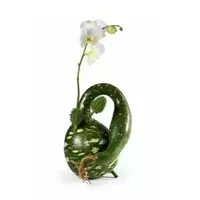Lagenaria

A herbaceous liana called lagenaria is assigned by scientific classification to the Pumpkin family and includes seven subspecies of the plants of the same name. Lagenaria pumpkin grows mainly in tropical climates, but some ornamental species of the plant can be found in our latitudes. The appearance of the lagenaria plant resembles a creeping liana. Usually the stem of the lagenaria reaches a length of 15 meters. The leaves of the lagenaria have a rather large corrugated pentagon shape. The pumpkin lagenaria blooms in small white inflorescences.
The fruits of the plant differ in their original appearance. Depending on the species of plant, in nature you can find round, oval or pear-shaped, as well as elongated and club-shaped fruits of lagenaria. The food is consumed just by the underaged and green fruits of the lagenaria. It is noteworthy that during ripening, the fruits of the lagenaria dry from the inside, and the shell, on the contrary, hardens due to the rocky cells that are part of the plant.
The fruits of lagenaria are used not only for food. Residents of Africa, Asia, as well as Latin America make dishes, tobacco pipes, toys and musical instruments from the fruits of lagenaria pumpkin. Lagenaria stems are used in the production of durable woven products and ropes, fatty oil is isolated from the plant seeds, which is used in cooking, medicine and the production of cosmetic products. The pulp of lagenaria fruits is characterized by a characteristic pumpkin taste.
Lagenaria refers to dietary and healing plants. It is worth paying attention to the unprecedented low calorie content of the plant. 100 grams of the product contains only 14 Kcal. In addition, you should pay close attention to the vitamin and mineral composition of the product. The chemical composition of lagenaria contains vitamins of group A, V1, V2, V3, V5, V9 and C, as well as such macro- and trace elements as phosphorus, potassium, sodium, calcium, iron, selenium, zinc and manganese. The useful properties of lagenaria have long been actively used in the people's medical community of African, Latin American and Asian peoples.
Regular consumption of lagenaria as food contributes to the treatment and prevention of diseases of the gastrointestinal tract. It has been scientifically proven that lagenaria contributes to the normalization of digestive and metabolic processes, which leads to a decrease in overweight. For these qualities and due to the low calorie content of lagenaria, the vegetable is referred to dietary products and included in the diet of patients with obesity and diabetes mellitus.
Lagenaria has a positive effect on the liver, bladder and kidneys of a person, and also helps in the treatment of severe forms of diseases of these organs. The high content of vitamin C in the plant indicates the ability of lagenaria to favorably affect the immune system of the human body. In addition, lagenaria is considered a natural antioxidant.
The plant helps to cleanse the human body from harmful compounds, slags, radionuclides, etc. The fruits of lagenaria are able to normalize and maintain the level of cholesterol and salts in the blood. Recent scientific studies have proven that the composition of lagenaria includes substances that are able to prevent the occurrence and slow down the growth of malignant cancer tumors.
lagenaria 14 kCal
Energy value of lagenaria (Ratio of proteins, fats, carbohydrates - ju):
Proteins: 0.62 g (~ 2 kCal)
Fats: 0.02 g (~ 0 kCal)
Carbohydrates: 0.39 g (~ 2 kCal)
Energy ratio (bj | y): 18% | 1% | 11%
 Español
Español Français
Français Português
Português Русский
Русский 简体中文
简体中文 繁體中文
繁體中文 日本語
日本語 한국어
한국어 العربية
العربية Türkçe
Türkçe Қазақ
Қазақ Deutsch
Deutsch Italiano
Italiano Українська
Українська
